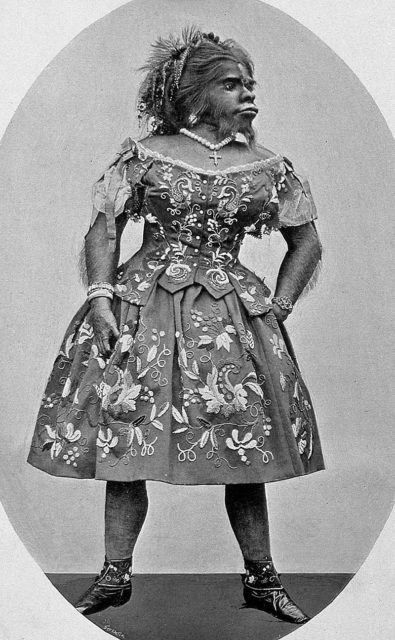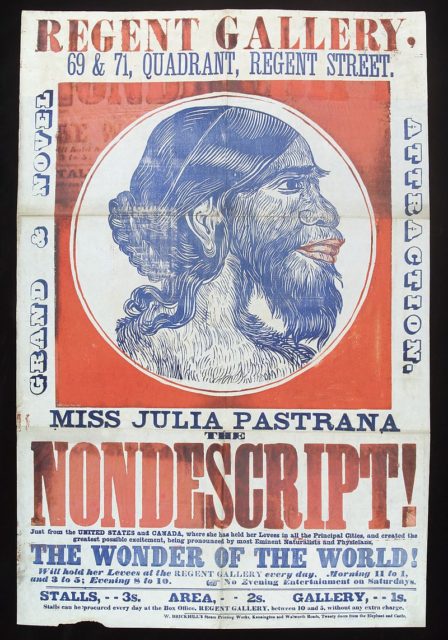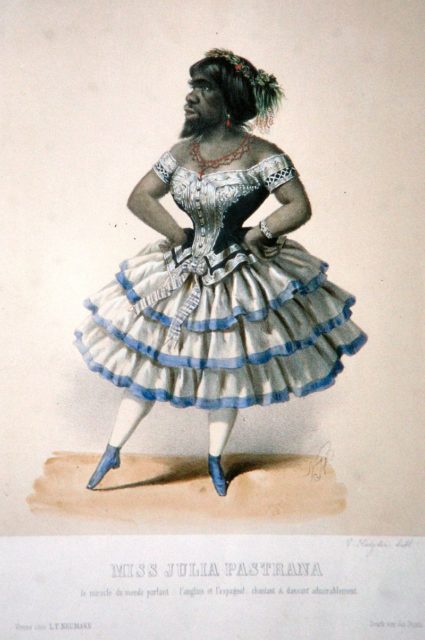Not so long ago, human zoos and freak shows were considered n acceptable form of entertainment; today they’re looked on with disgust as ethical boundaries are violated for fame and profit. In the 19th century, one such human curiosity was the “bearded lady.” Julia Pastrana was exhibited during her lifetime, and for quite some time after her death. It was not until 2013 that she was finally laid to rest in her birthplace of Mexico with a proper burial.
Julia Pastrana was born in the mountains of Western Mexico in 1834. Her life was defined by her appearance. She grew only to 4 feet 5 inches tall and 112 pounds in weight but what was fascinating about her to most people was that her entire body was covered with hair except the palms of her hands and the soles of her feet. Her peculiar looks were a result of a rare congenital condition known as acromegaloid hypertrichosis syndrome, which covered her body with thick hair and caused unusual facial features, including abnormally thick lips and a large jaw. Pastrana also had a very prominent brow with thick, arched eyebrows, her nose was unusually large, and she had irregular teeth.
Her mother was convinced that some sort of supernatural force was to blame for her daughter’s looks, while the local Mexican tribes blamed the naualli–shape-shifting werewolves that were said to cause stillbirths and deformities.

Young Julia spent her childhood in an orphanage, becoming a local celebrity because of her unusual appearance. After hearing about her, the state governor adopted Julia to serve him as a live-in entertainer and maid. She stayed in his home until she was 20, when she decided to return to her tribe.
However, she never completed her journey, because on her way home, she encountered M. Rates, an American showman, who persuaded her to perform onstage. Soon after, she began her career in the United States and Europe, taking part in traveling freak shows and circuses.

Julia gained success as a performer, variously known as “the Ape Woman” or “Baboon Lady.” Her debut took place at the Gothic Hall on Broadway in New York City in 1854. She wore a red dress and sang Spanish songs while dancing the Highland Fling. A huge audience flocked to her shows, looking forward to seeing the “Bear Woman from the wilds of Mexico!” as she was advertised. One newspaper account of the time described her with the following words: “The eyes of this unusual natura beam with intelligence, while its jaws, jagged fangs and ears are terrifically hideous…nearly its whole frame is coated with long glossy hair. Its voice is harmonious, for this semi-human being is perfectly docile, and speaks the Spanish language.
The idea of Julia as a semi-human being was established by the physician Alexander B. Mott, who examined her and declared her to be a hybrid of human and orangutan. It’s worth noting that at the time, orangutans were considered as the wildest, most primitive primates with a dangerous sexuality. Julia’s PR also supported this claim, sharing promotional material that underlined her animalistic otherness. In it, she was described as originating from a tribe of “Root-Digger Indians” who were “spiteful and hard to govern,” living with animals and indulging in intimate relations with them.
Julia was in truth a kind-hearted, gentle woman. She was highly intelligent, an avid learner who taught herself how to sing and dance, and she spoke three languages, including English. She loved to travel, cook, and sew and was willing to submit herself to medical research that included an examination of her condition which puzzled so many doctors back then.
Before she was brought to Europe, Julia married her next manager, Mr. Theodor Lent, but their marriage happened in secret. Many believed that Julia was quite fond of him and married for love, while Theodor did so in order to gain entire control over her earnings. In one of the interviews for the press, Julia declared to have turned down over 20 marriage proposals because the men weren’t wealthy enough.
In 1857, in Leipzig, Germany, Julia appeared on stage in a play that was written especially for her. The promotional posters for the show gave her a quite grotesque look, as her lips were given an exaggerated red color, similar to the radicalized images of African-Americans at the time. When the German audience saw Pastrana, they considered her show in bad taste and rejected it. The situation quickly got out of control, causing an intervention by the police who had to stop the show. After that, Julia was more discretely exhibited.

In January 1860, while she was in Moscow, she gave birth to a baby boy who died only two days later. Three days after the boy’s death, Julia herself passed away and the last words on her deathbed were: “I die happy. I know I have been loved for myself.”
The other tragic tale tells the story of Julia’s husband and manager selling the bodies of both her and the child to an anatomy professor, Sukolov, in Moscow. Sukolov embalmed both of the bodies and publicly displayed them. When Lent heard how lucrative Sukolov’s actions were, he asked for the bodies back. After regaining control over Julia’s body and that of her son, for the next six years Lent exhibited them in glass cabinets around the world.
Read another story from us: The heartbreaking story of Joseph Merrick, the real “Elephant Man”
While on tour, he met the woman Marie Bartel, who much resembled Julia since she was also suffering from the rare condition. He took advantage of her position and married her, renaming her Zenora Pastrana, and he publicly presented her as Julia’s sister. He hid the embalmed bodies, and he started deceiving people that Zenora and Julia were the exact same person. He extended the fraud after Zenora’s death, parading with her mummified body at numerous shows and exhibits.
The corpses were stolen and later disposed of in Norway, where they were finally recovered by the police in 1967. The bodies were kept in storage in the university in Oslo until, in 2005, the Mexican artist Lauren Anderson Barbata brought Julia’s body back to Mexico. She told the New York Times “I felt she deserved the right to regain her dignity and her place in history and in the world’s memory.” Finally, on February 12, 2013, Julia Pastrana was buried and laid to rest.
